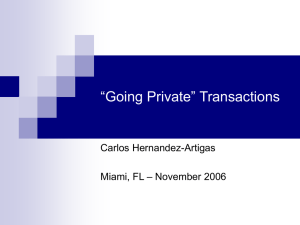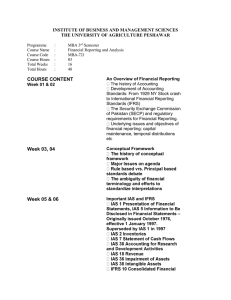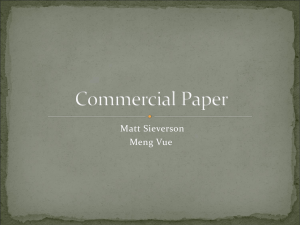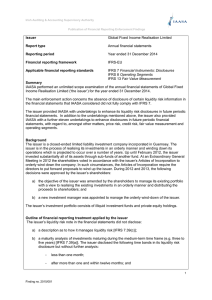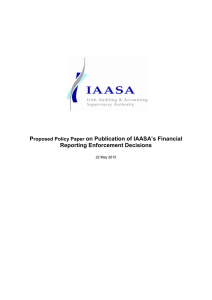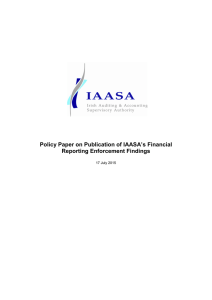Financial Reporting Decisions 13 January 2016
advertisement
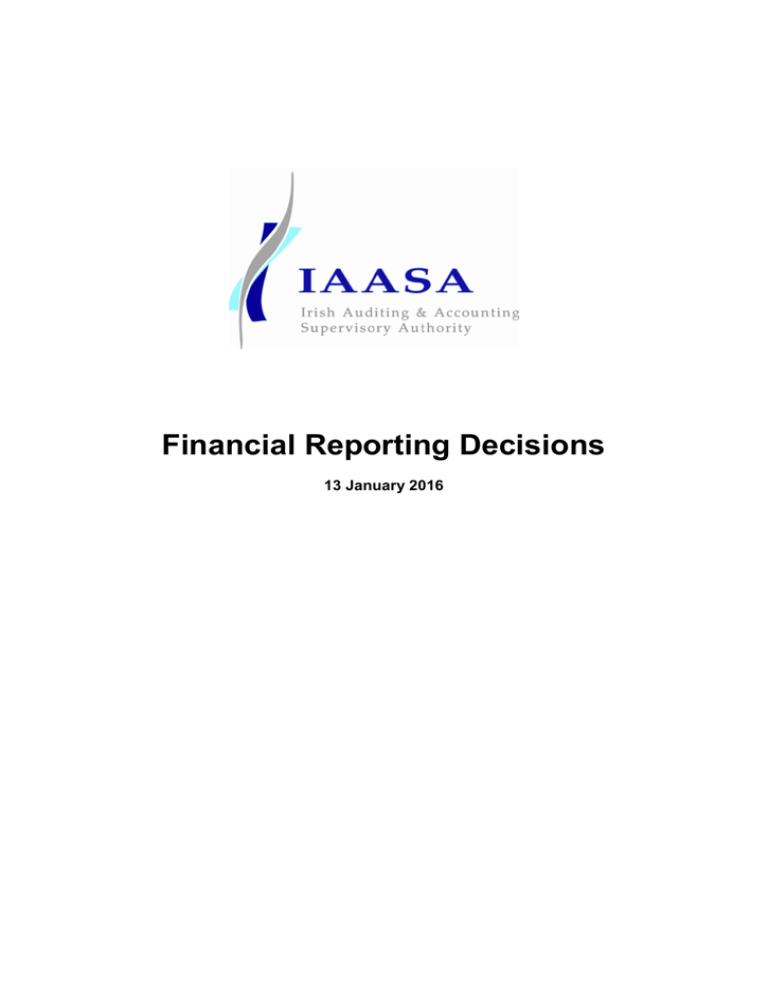
Financial Reporting Decisions 13 January 2016 Contents Page 1. 2016/001 – C&C Group plc .................................................................................................... 1 – 2 2. 2016/002 – Mainstay Medical International plc ..................................................................... 3 – 4 3. 2016/003 – Smurfit Kappa Group plc .................................................................................... 5 – 6 4. 2016/004 – Lusitano Mortgages No. 1 plc and Lusitano Mortgages No 2 plc ..................... 7 – 9 5. 2016/005 – UT2 Funding plc .............................................................................................. 10 – 11 Readers should note that the financial reporting decisions included in this compendium include decisions where: a) the issuer has voluntarily provided undertakings to enhance its financial reporting treatment and/or disclosures in future financial statements to address matters identified in the course of IAASA’s examinations; and b) IAASA concurred with the financial reporting treatment applied by the issuer and, consequently, no corrective actions are required. Readers may find it helpful to refer to IAASA’s Policy Paper on Publication of IAASA’s Financial Reporting Enforcement Findings. Issuer C&C Group plc Report type Annual report Reporting period Annual report for the year ended 28 February 2015 Financial reporting framework IFRS-EU Applicable financial reporting standards IAS 36 Impairment of Assets Summary This financial reporting enforcement finding concerns the disclosure approach adopted by C&C Group plc (‘the issuer’) in respect of the sensitivity of the recoverable amount of cash generating units (‘CGUs’) to impairment. This particularly relates to CGUs which have significant amounts of goodwill and intangible assets and where there is limited or no headroom. The issuer gave an undertaking to IAASA to provide particular disclosures required by paragraph 134(f) of IAS 36 in future reports. Background The issuer is a manufacturer, marketer and distributer of branded cider, beer, wine and soft drinks and has operations in Ireland, Scotland, England, Wales and North America (United States and Canada). Entities are required to provide additional disclosures where a reasonably possible change in a key assumption(s) would cause the carrying value of a CGU or group of CGUs to exceed the recoverable amount. For example, this might arise where there is limited headroom, where the carrying value of a CGU or group of CGUs is already at the recoverable amount or where a reasonably possible change in assumption(s) would cause the carrying amount to exceed the recoverable amount (IAS 36.134(f) refers). IAASA performed an unlimited scope examination of the annual financial statements for the year ended 28 February 2015. Outline of financial reporting treatment applied by the issuer During the year ended 28 February 2015 a review of the carrying value of all intangible asset values was completed by the issuer and, as a result of this review, an impairment charge of €150m was recognised with respect of the issuer’s intangible assets in the US. This impairment was made up of €76m of goodwill and €74m of intangible assets. This represented a write down of approximately 19% of the issuer’s intangible assets. After the impairment of one North American CGU, all the goodwill and a material part of the intangible assets was written off. Under the heading ‘Goodwill and Intangible assets - sensitivity analysis’ and referring to the North American CGUs, it was stated that any variation to the value in use input assumptions would result in a further impairment charge. Quantitative data of the sensitivities of CGUs to reasonably possible changes in key assumptions were not disclosed in the financial statements. Outline of findings made by IAASA Two North American CGUs have been written down to their recoverable amounts. Therefore, it is the view of IAASA that North American CGUs are highly sensitive to any variation in the key assumptions leading to possible further impairment of the recoverable amount of North American CGUs. Increased competition in the North American cider market has been identified in the financial statements as a principal risk and, therefore, a further increase in competition could also negatively impact the issuer’s North American CGU’s value in use assumptions. Decision 2016/001 1 IAS 36.134(f) states that if a reasonably possible change in a key assumption on which management has based its determination of the CGU’s recoverable amount would cause the CGU’s carrying amount to exceed its recoverable amount, an issuer shall disclose: a) the amount by which the CGU’s (group of CGUs’) recoverable amount exceeds its carrying amount; b) the value assigned to the key assumption; and c) the amount by which the value assigned to the key assumption must change, after incorporating any consequential effects of that change on the other variables used to measure recoverable amount, in order for the CGU’s (group of CGUs’) recoverable amount to be equal to its carrying amount. The issuer confirmed to IAASA that they did not disclose information required by IAS 36.134(f) on the basis that the entire goodwill assigned to one North American CGU was impaired whilst another North American CGU was partially impaired. IAASA noted the remaining North American CGUs retained a significant amount of intangible assets. IAASA examined the detailed impairment workings provided by the issuer together with data to support the issuer’s CGU value in use key assumptions including: a) the weighted average cost of capital (‘WACC’) calculations for a number of CGUs; b) industry data supporting the long term growth rate for the North American market; and c) an external consultant’s report that was relied upon to support the issuers North American CGU discount rate. IAASA concluded that one North American CGU was vulnerable to further impairments given that there was no further headroom available. Therefore, in the circumstances and in the absence of disclosures required by IAS 36.134(f), IAASA concluded that the issuer had not complied in full with IAS 36.134(f). Outline of corrective actions undertaken or to be undertaken The issuer undertook to provide the disclosures required by IAS 36.134(f) in future reports. Return to Contents Decision 2016/001 2 Issuer Mainstay Medical International plc Report type Annual financial statements Reporting period Period ended 31 December 2014 Financial reporting framework IFRS-EU Applicable financial reporting standards IAS 24 IAS 1 IAS 12 IFRS 3 IAS 8 Related Party Disclosures Presentation of Financial Statements Income Taxes Business Combinations Accounting Policies, Changes in Accounting Estimates and Errors Summary This unlimited scope examination of the annual financial statements of Mainstay Medical International plc (‘the issuer’) resulted in two financial reporting decisions meeting IAASA’s publication crirteria, namely: a) the issuer providing IAASA with undertakings to enhance disclosures in future periodic financial statements regarding related party disclosures required by IAS 24 Related Party Disclosures; and b) IAASA accepting the issuer’s financial reporting treatment for the transfer of pre-acquisition losses to a “re-organisation reserve”. Background The issuer is a medical device company incorporated on 17 February 2014. On 2 May 2014 the issuer completed an initial public offering and its shares were admitted to trading on both the Euronext Paris Stock Exchange (a regulated market) and on the Irish Stock Exchange’s Enterprise Securities Market. IAASA performed an unlimited scope examination of the issuer’s annual financial statements for the period ended 31 December 2014. Outline of financial reporting treatments applied by the issuer Related party disclosures In the financial statements, the issuer’s related party transactions note: a) defined key management personnel (‘KMP’) as “executive directors and senior management”; and b) cross referred to the Directors’ Report for information regarding the fees paid to the nonexecutive directors. Re-organisation reserve During 2014 a corporate re-organisation was undertaken whereby a new entity (i.e. the issuer) was incorporated and became the new parent entity of the Mainstay Medical group. This re-organisation was accounted for using the merger method of accounting. One of the impacts of the re-organisation was the transfer of the pre-acquisition losses to a “re-organisation reserve”. The transfer is to distinguish the pre-acquisition losses from future post-acquisition profits/losses. Outline of findings made by IAASA Related party disclosures Decision 2016/002 3 IAASA concluded that the issuer’s KMP definition did not fully comply with IAS 24.9 as the nonexecutive directors should be included within the KMP definition. IAASA concluded that the cross reference from the related party note to the information contained in the Directors’ Report did not fully comply with the requirements of IAS 24.17. The relevant remuneration disclosures in the directors’ report in this instance derived from Corporate Governance Code requirements. IAS 24.17 contains disclosure requirements for the KMP compensation within IFRS financial statements. The requirements of the Corporate Governance Code and IAS 24.17 are not identical in this respect. Re-organisation reserve IAASA initially considered that the retained loss reserve should be unaffected as the merger method of accounting assumes that the combining entities had always been combined. However, IFRS 3 does not provide specific guidance on the financial reporting treatment for group reorganisations. The issuer used the hierarchy of IAS 8 for guidance and identified specific guidance for merger accounting in the local Irish/UK GAAP FRS 6 Acquisitions and Mergers. The issuer stated that this financial reporting treatment is established practice in Ireland. IAASA concurred with the issuer in its use of this existing Irish/UK accounting standard to account for the matter. Given the general practice being applied in this regard, IAASA discussed the matter with its colleagues within the European accounting enforcers group and with IFRS Interpretations Committee representatives. The International Accounting Standards Board (IASB)’s project “Business Combinations under Common Control” (‘BCUCC’) is on-going at the time of writing and IAASA has raised this specific matter as part of that project. It is noted that the outcome of the IASB project could be a separate standard on BCUCC or may result in an amendment to IFRS 3. In light of the above IAASA accepted the issuer’s financial reporting treatment regarding the reorganisation reserve. Outline of corrective actions undertaken or to be undertaken Following engagement with IAASA, the directors undertook to: a) update the definition of “Key Management Personnel” to reflect the IAS 24.9 definition in future periodic financial statements; and b) include the non-executive and executive directors’ fees in the related party note in future periodic financial statements. The issuer agreed to provide further narrative in future periodic financial statements regarding the nature of the re-organisation reserve. IAASA accepted the issuer’s financial reporting treatment regarding the re-organisation reserve. Return to Contents Decision 2016/002 4 Issuer Smurfit Kappa Group plc Report type Half-yearly financial report Reporting period Six month period ended 30 June 2015 Financial reporting framework IFRS-EU Applicable financial reporting standards IAS 21 The Effects of Changes in Foreign Exchange Rates Summary This financial reporting decision concerns the exchange rate used by Smurfit Kappa Group plc (‘the issuer’) to consolidate the results, assets and liabilities of its operations in Venezuela under IAS 21 The Effects of Changes in Foreign Exchange Rates. It also relates to the associated disclosures in the issuer’s half-yearly financial report. IAASA concurred with the issuer’s financial reporting treatment. Background The issuer is a global manufacturer with around 40,000 employees across more than 30 countries and annual revenues in excess of €8bn. The issuer has operations in Venezuela. IAASA performed an unlimited scope examination of the half-yearly financial report of the issuer for the six month period ended 30 June 2015. The application of IAS 21 in instances where more than one foreign exchange rate exists was an area of focus for IAASA as, in 2014 and early 2015, European Securities and Markets Authority (‘ESMA’) considered the application of IAS 21 and ESMA has now included the subject in its 2015 Common 1 Enforcement Priorities . Outline of financial reporting treatment applied by the issuer The Venezuelan currency is the Venezuelan Bolivar Fuerte or ‘VEF’ and is subject to strict currency restrictions and is not freely exchangeable. As at 30 June 2015 there were multiple official rates of exchange of VEF to US dollars (US$) and the disparity between the different rates was significant. There are three legal exchange rates between the VEF and US$, namely: a) CENCOEX - The ‘official rate’ which apples to State transactions and to the import of vital goods such as food or medicine; b) SICAD – a variable average based on auctions; and c) SIMADI – a daily variable average based on free market transactions. Consequently, the determination of the appropriate rate of exchange at which to consolidate the issuer’s Venezuelan operations has a material impact on the financial statements. In the first quarter of 2015, the Venezuelan government announced changes to its system of multiple exchange rates for the VEF as follows: a) the SICAD I and SICAD II rates were unified into a single variable SICAD rate, which was 1 ‘Issuers with significant exposure to a country at risk, in which more than one foreign exchange rate exists, should provide information about the exposure, the foreign exchange rate and an analysis of the main judgements used (e.g. the judgements made and the reasons for selecting one specific foreign exchange rate rather than another), as well as a sensitivity analysis where relevant. In addition, IFRS 7 requires issuers to disclose information about their exposure to credit, market and liquidity risks, including concentrations of risk. ESMA encourages issuers to adapt the level of detail of the information provided based on their level of exposure.’ Decision 2016/003 5 US$1 = VEF 12.8 at 30 June 2015; b) anew rate, SIMADI, was created to allow individuals and businesses to buy and sell foreign currency more easily and to offset the parallel market rate. The SIMADI rate was US$1 = VEF 197 at 30 June 2015; and c) the existing ‘official rate’ (CENCOEX) continues to be fixed at US$1 = VEF 6.3. The issuer changed the rate at which it consolidates its Venezuelan operations from the SICAD rate to the SIMADI rate during the half-year period. The issuer believes that the SIMADI rate is the most appropriate rate for accounting and consolidation, as it believes that this is the rate at which it extracts economic benefit. The change from the SICAD rate to the SIMADI rate reduced the reported cash on the Condensed Consolidated Balance Sheet of the issuer by approximately €100m and its net assets by approximately €600m. Following this change, the issuer’s operations in Venezuela now account for 2 less than 1% of consolidated EBITDA . In the narrative and in the notes in its half-yearly financial report, the issuer has disclosed: a) the accounting treatment applied in the six month period in respect of the exchange rate used by the issuer to consolidate the results, assets and liabilities of its operations in Venezuela. Such disclosure included information about the foreign exchange rate used; b) the impact of changes to the rates of exchange used compared to the previous full year rates; and c) the rationale and judgment made by management for applying the SIMADI rate during the half-year period. Outline of decision made by IAASA IAASA concurred with the issuer’s financial reporting treatment and disclosures. IAS 21.26 states that: ‘When several exchange rates are available, the rate used is that at which the future cash flows represented by the transaction or balance could have been settled if those cash flows had occurred at the measurement date.’ Recognising that IAS 21.26 requires the exercise of management judgement, IAASA did not disagree with the issuer’s assertion that that the SIMADI rate is the most appropriate rate for accounting and consolidation, as it believes that this is the rate at which it extracts economic benefit. Outline of corrective actions undertaken or to be undertaken None required as IAASA concurred with the issuer’s financial reporting treatment and disclosures. Return to Contents 2 Earnings before Interest, Taxation, Depreciation and Amortisation Decision 2016/003 6 Issuer Lusitano Mortgages No 1 plc and Lusitano Mortgages No 2 plc Report type Annual financial statements Reporting period Year ended 31 December 2014 Financial reporting framework IFRS-EU Applicable financial reporting standards IFRS 13 Fair Value Measurement IFRS 7 Financial Instruments: Disclosures IAS 7 Statement of Cash Flows IAS 24 Related Party Disclosures Summary Lusitano Mortgages No. 1 plc and Lusitano Mortgages No 2 plc (‘the issuers’) provided IAASA with a number of undertakings to ensure compliance, in full, with certain financial reporting standards, In particular, the issuers have agreed to provide additional disclosures in future financial statements with regard to, amongst other matters: a) fair value measurement disclosure; b) credit risk policies disclosure; c) Statement of Cash Flows; and d) related parties disclosures. The matters identified were similar for each issuer except as outlined in the detail below. Background The principal activities of the issuers are the investment in a portfolio of mortgage receivables in Portugal through the purchase of 100% of the units in subsidiaries, which are Portuguese securitisation funds. The underlying portfolio was originated by a Portuguese bank (‘the Originator’) and are serviced by one of the subsidiaries of the Originator. Investments are financed by issuing debt securities whose values are determined by the underlying loans and receivables. The investments in loans and receivables were carried at amortised cost and the equivalent fair values are disclosed by way of note in accordance with IFRS 13.97. The issuers classified the loans and receivables (assets) as Level 2 prices. One class of debt security issued was classified as Level 2 in the fair value hierarchy and the remaining debt securities were classified as Level 3 prices in the fair value hierarchy as defined in IFRS 13.72 to 90. IAASA performed an unlimited scope examination of each issuer’s annual financial statements for the year ended 31 December 2014. Outline of financial reporting treatment applied by the issuers and outline of decisions made by IAASA Financial reporting treatment applied by the issuers Outline of decisions made by IAASA 1. IFRS 13 Fair value measurement: Fair value disclosures Loans and investments (assets) were carried at amortised cost and their corresponding fair Decision 2016/004 IAASA concluded that the issuers had not provided the fair value disclosures (required for each class 7 values were disclosed in the notes to the financial statements. It was stated in the financial statements that, due to the unique aspects of the notes in issue, and the complex and detailed assumptions and methods used, detailed disclosure for the valuation techniques used had not been provided. The financial statements also disclosed that the carrying value of all the financial assets and financial liabilities approximate their fair values. of asset and liability) that were not measured at fair value in the statement of financial position but for which the fair value is disclosed (IFRS 13.97 refers). IAASA also concluded that the complexity of the valuations and assumptions were not a valid reason for not providing the required fair value disclosures. Following engagement with IAASA, the issuers undertook to provide the following disclosures in future financial statements: a) the disclosures required by IFRS 13.97 and IFRS 13.93(d) where securities are not measured at fair value but where the fair value is disclosed; b) a narrative description of the sensitivity analysis of financial assets and financial liabilities in full compliance with IFRS 13.97 13.93(i); c) re-classification of selected debt securities issued from Level 3 to Level 2 in future financial statements on the basis of there being no significant unobservable inputs; and d) restrict the statement “the carrying amount of debt securities and loans and receivables approximate their fair values” to short-term assets and liabilities in future financial statements. 2. IFRS 7 Financial Instruments: Disclosure – credit risk It was noted from the financial statements that the objective of risk management is to manage and control risk exposures within acceptable parameters and that the issuers have appointed third party service providers to manage credit risk on behalf of the issuers. IAASA concluded that there was insufficient disclosure of the issuers’ own entity specific objectives, policies and processes for managing the credit risk and the methods used to measure the risk in accordance with IFRS 7.31 to 38 and, in particular, 7.36. Following engagement with IAASA the issuers undertook to provide the following disclosures in future financial statements: a) a quantification of any additional minimum credit limits set by the issuer for any investments or counterparties (if any); b) additional quantitative data of the collateral pledged that is necessary for an understanding of changes in the credit risk during the period; and c) any breach of the warranties given by the originator during the period and details of that breach (if any). Decision 2016/004 8 3. IAS 7 Statement of Cash Flows – classification of cash flows During the year the Lusitano Mortgages No 1 plc had drawn €30m from the Liquidity Provider. The €30m drawn down during 2014 was classified and presented as operating cash flows in the Statement of Cash Flows. When IAASA queried the classification of the €30m drawn as operating cash flows, the issuer acknowledged that the €30m was incorrectly classified as operating, rather than financing, in the Statement of Cash Flows. The issuer undertook to correct this classification in the Statement of Cash Flows in its 2015 annual financial statements. 4. IAS 24 Related Party Disclosures The issuers stated in the notes to the financial statements that they did not consider any of the parties listed on page 1 of the Annual Report as related parties in accordance with the criteria set out in IAS 24. This implied that the directors were not regarded as being related parties. When IAASA queried why the directors were not regarded as related parties, the issuers accepted that the directors were related parties as defined by IAS 24.9. The issuers confirmed that no direct transactions arose with the directors and the issuers during the year. The issuers undertook to correct the disclosures in the 2015 annual financial statements. 5. Other matters Following engagement with IAASA, the issuers undertook to provide and/or enhance disclosures in future financial statements in the following areas: a) provide disclosure of the effect of rights of setoff associated with financial instruments that are subject to an enforceable master netting arrangement or similar agreement (in accordance with IFRS 7.13A to 13F refer); and b) quantify and disclose by class of note issued, the carrying amount of assets it has pledged as collateral and assets pledged as collateral for borrowing facility (IFRS 7.31 to 42 refer). Return to Contents Decision 2016/004 9 Issuer UT2 Funding plc Report type Half yearly report Reporting period Half year ended 28 February 2015 Financial reporting framework IFRS-EU Applicable financial reporting standards IAS 34 Interim Financial Reporting Summary This financial reporting finding concerns the treatment adopted by UT2 Funding plc (‘the issuer’) in respect of the restatement of the comparative amounts in the Statement of Cash Flows without providing the disclosures required by the relevant financial reporting standards. The restatements resulted from an examination by IAASA of the previous half year financial report (2014). The issuer provided an undertaking to IAASA to provide the relevant disclosures required by IAS 34 in future periodic financial statements. Background The issuer is established as a public limited company in order to invest in debt instruments of an investment bank, the returns of which are linked to the profits of the underlying investment bank. IAASA performed a focused examination of the half yearly financial report for the 6 months ended 28 February 2015. Outline of financial reporting treatment applied by the issuer IAASA had examined the previous year’s half yearly financial report. Consequently, the issuer had given undertakings to correct the presentation of a number of amounts in the Statement of Cash Flows in order to comply in full with the relevant aspects of IAS 34 and IAS 7 Statement of Cash Flows. The undertakings included corrections to the following: the opening profit before tax figure; and the treatment of cash flows from interest and taxes paid/receivable. These corrections arose because the issuer had not accounted correctly for the following items: a) the opening figure in the Statement of Cash Flows was the profit after tax (rather than profit before tax as required by IAS 7); b) the interest paid on bank interest amounting to €1,954,683 had not been disclosed as a separate line item in the Statement of Cash Flows as required by IAS 7.31; and c) because of the incorrect netting outlined at b) above, a non cash adjustment on another line item on the face of the Statement of Cash Flow was understated by €1,954,683. Resulting from this, the issuer restated a number of comparative items in the 2015 half yearly Statement of Cash Flows. During a follow up examination to ensure that all undertakings had been fulfilled, it was noted that the issuer did not provide any disclosure that explained the basis for the changes to the comparative amounts in the 2015 Statement of Cash Flows. Decision 2016/005 10 Outline of findings made by IAASA IAS 34.5(d) refers to the Statement of Cash Flows and links it to IAS 7. IAS 34.16A(a) requires that if accounting policies or methods have been changed, a description of the nature and effect of the change is required. By way of analogy IAS 1.41 describes information that is disclosed when an entity reclassifies comparative amounts. It states that when an entity reclassifies comparative amounts it shall disclose: a) the nature of the reclassification; b) the amount of each item or class of items that is reclassified; and c) the reason for the reclassification. IAASA concluded that the issuer had failed to comply with IAS 34.16A(a). Outline of corrective actions undertaken or to be undertaken The issuer undertook that in the event that amounts are restated in future annual or half yearly reports they will comply in full with IAS 34.16A(a). In this context, they will provide the required disclosures highlighting the nature, amount and reason for the restated amounts in the Statement of Cash Flows. Return to Contents Decision 2016/005 11



